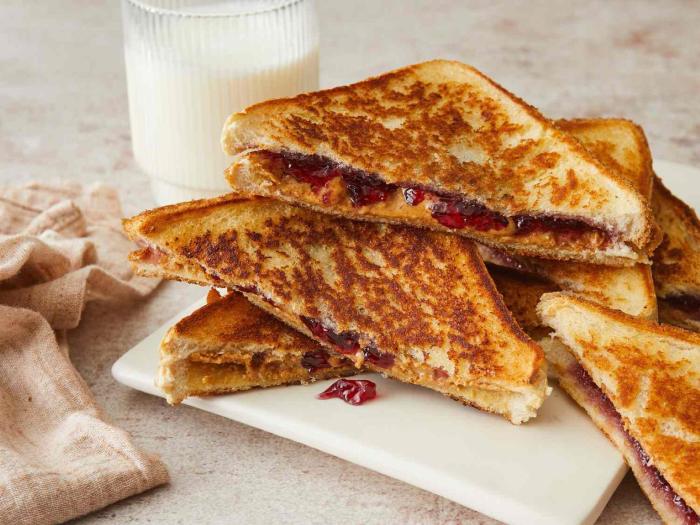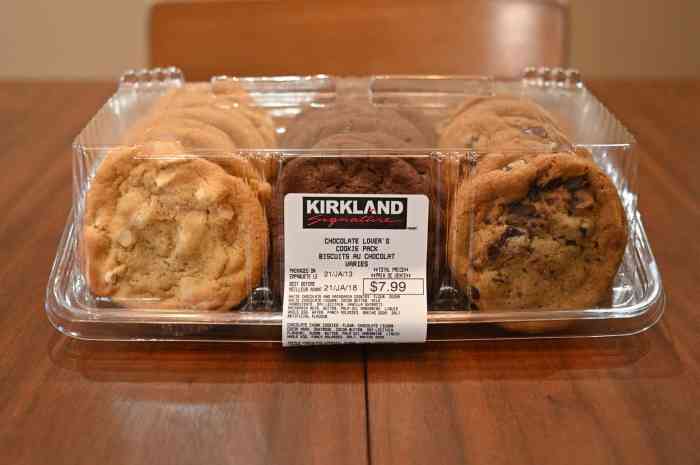Nutritional Composition of a PB&J Sandwich

Nutrition facts for pb and j sandwich – A peanut butter and jelly sandwich, a classic lunchtime staple, offers a surprisingly diverse nutritional profile. The specific nutritional content varies depending on the ingredients used, such as the type of bread, peanut butter, and jelly. This section provides a detailed breakdown of the macronutrients and micronutrients typically found in a standard PB&J sandwich, along with the impact of ingredient variations.
Macronutrient Breakdown of a PB&J Sandwich
The following table details the macronutrient composition of a typical PB&J sandwich made with two slices of white bread, two tablespoons of peanut butter, and one tablespoon of grape jelly. These values are approximate and can fluctuate based on specific brands and serving sizes.
Understanding the nutrition facts for a peanut butter and jelly sandwich involves considering the bread, peanut butter, and jelly components. For a healthier twist, you might consider adding a serving of vegetables, and for a quick nutritional boost, you could check out the cherry tomato nutrition facts – they’re a low-calorie, vitamin-rich option. Returning to the PB&J, remember to watch your portion sizes to manage overall calorie and sugar intake.
| Nutrient | Amount per Serving | % Daily Value | Source |
|---|---|---|---|
| Carbohydrates | ~35g | ~12% | Bread (primarily), Jelly |
| Protein | ~8g | ~16% | Peanut Butter (primarily), Bread |
| Fat | ~12g | ~18% | Peanut Butter (primarily) |
Micronutrient Content of a PB&J Sandwich
A PB&J sandwich also contributes several essential micronutrients to the diet. The specific amounts vary depending on the ingredients, but generally, a standard sandwich provides:
- Vitamin E: Primarily from peanut butter, a good source of this important antioxidant.
- Vitamin B3 (Niacin): Found in both peanut butter and bread, contributing to energy metabolism.
- Magnesium: Present in peanut butter and bread, important for muscle function and bone health.
- Potassium: Contributes to electrolyte balance, found in varying amounts depending on the bread and jelly.
- Folate: Small amounts present in bread, contributing to cell growth and development.
Impact of Bread Type on Nutritional Profile
The choice of bread significantly impacts the overall nutritional value of a PB&J sandwich. Whole wheat bread, compared to white bread, generally offers:
- Higher Fiber Content: Promoting digestive health and contributing to feelings of fullness.
- More Vitamins and Minerals: Including B vitamins and minerals like iron and magnesium.
- Lower Glycemic Index: Leading to a slower release of sugar into the bloodstream, preventing energy crashes.
Switching from white bread to whole wheat bread substantially enhances the nutritional profile of a PB&J sandwich, making it a more balanced and healthful choice. For example, a sandwich made with whole wheat bread might contain significantly more fiber, leading to improved digestion and satiety compared to a sandwich made with white bread.
Allergens and Dietary Considerations

A peanut butter and jelly sandwich, while a classic and convenient meal, presents several potential allergens and necessitates careful consideration for individuals with specific dietary needs and health conditions. Understanding these factors is crucial for ensuring safe and healthy consumption.
Common Allergens and Substitutes
Peanut butter and jelly sandwiches contain common allergens that can trigger severe reactions in susceptible individuals. The following table Artikels these allergens, potential substitutes, and the nutritional implications of these substitutions.
| Allergen | Potential Substitute | Nutritional Differences |
|---|---|---|
| Peanuts | Sunflower seed butter, almond butter, or soy nut butter | Varying fat and protein content; sunflower seed butter generally lower in protein and fat than peanut butter; almond butter higher in fat and protein. Nutritional information varies greatly depending on the brand and type of nut butter. |
| Tree Nuts (depending on the jelly) | Check ingredient labels carefully. Some jellies contain tree nut extracts or are processed in facilities that also process tree nuts. Consider using a jelly with a certified allergen-free label. | Nutritional impact varies based on the specific nut and its quantity in the jelly. Always refer to the nutrition label for detailed information. |
| Soy (depending on the jelly) | Look for jellies without soy lecithin or other soy-derived ingredients. | Minimal nutritional difference if a soy-free alternative is used. |
| Wheat (depending on the bread) | Gluten-free bread | Lower in gluten, potentially lower in fiber and certain nutrients depending on the specific gluten-free bread. |
Dietary Considerations for Specific Health Conditions, Nutrition facts for pb and j sandwich
The nutritional composition of a PB&J sandwich needs careful consideration for individuals managing specific health conditions.For individuals with diabetes, the high carbohydrate content from bread and jelly can significantly impact blood sugar levels. Choosing whole-wheat bread and a low-sugar jelly can help mitigate this. Portion control is also vital. A smaller sandwich, or one with added protein such as a thin layer of sliced turkey or avocado, could provide better glycemic control.Individuals with high blood pressure should be mindful of the sodium content in both the bread and the jelly.
Opting for low-sodium bread and checking the sodium content of the jelly can help manage sodium intake. Reducing the amount of jelly used can also decrease the overall sodium content.Individuals with high cholesterol should consider the fat content, particularly saturated and trans fats, present in peanut butter and bread. Choosing a peanut butter with lower saturated fat content and whole-wheat bread can be beneficial.
Visual Representation of Nutritional Profiles
Imagine two bar graphs side-by-side. The first represents a standard PB&J sandwich made with white bread, high-sugar jelly, and regular peanut butter. The bars representing carbohydrates and sugars are significantly taller than those for protein and fiber. The fat bar is moderately high. The second graph represents a healthier alternative: whole-wheat bread, low-sugar jelly, and peanut butter with reduced saturated fat.
In this graph, the carbohydrate bar is shorter, the sugar bar is significantly reduced, the protein and fiber bars are taller, and the fat bar is slightly shorter. This visual comparison clearly highlights the difference in the nutritional composition between the two versions of the sandwich.
Quick FAQs: Nutrition Facts For Pb And J Sandwich
Can I make a PB&J sandwich suitable for a diabetic diet?
Yes, choose whole-wheat bread for fiber and opt for a low-sugar or sugar-free jelly. Portion control is also crucial for managing blood sugar levels.
Are there any vegetarian or vegan alternatives to peanut butter in a PB&J?
Yes, sunflower seed butter, almond butter, or soy butter can be used as substitutes. Nutritional values will vary.
How can I reduce the sodium content of my PB&J?
Choose reduced-sodium bread and peanut butter options. Be mindful of added salt in some jelly varieties.
Is a PB&J sandwich a good source of protein?
Yes, peanut butter provides a significant amount of protein, making it a valuable component of a balanced meal, especially for children and adults needing extra protein.
What are the best bread choices for a healthier PB&J?
Whole-wheat bread offers more fiber and nutrients compared to white bread. Look for options with added grains for extra nutritional benefits.









